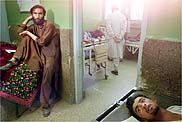December 10, 2001
War's Hidden Cost
By JOHN H. CUSHMAN Jr.
 |
| (Stephen Crowley/The New York Times) |
| In a Jalalabad hospital, an 18 year old, said to have been wounded by an American bomb, lies on a stretcher. |
WASHINGTON
THIS much is all but certain: when bombs fall, some of them will fall on the wrong people. Sometimes innocents are killed, in what is coolly referred to as collateral damage. Sometimes comrades in arms die and the military call it fratricide or, more chillingly, friendly fire.
Last week in Afghanistan, there were episodes of both. Dozens of noncombatants evidently died in a bombing strike that the Pentagon said hit an enemy complex of caves, tunnels and fortified encampments in the steep mountains around Tora Bora. Among the dead and living pulled from the rubble were dozens of women and children.
Of course, in this war as in every other, nobody ever really knows how many civilians are killed or wounded. The Taliban's tallies are not widely trusted, and with few forces on the ground, the Pentagon makes no attempt to estimate how many civilians its bombs have killed. Nor is it likely to attempt this later, though the Red Cross and human rights groups might.
Before every airstrike, the military does assess the risks to civilians, and legal officers must determine in advance that the risks are justifiable. Sometimes they veto proposed targets. But only in the event of a reported atrocity by United States forces would an investigation be carried out, as it was after the My Lai massacre in Vietnam.
It is clear that in the current conflict — part civil war, part holy war, part retribution for a terrorist outrage — no civilian is safe. In a survey of Afghanistan two years ago, the International Committee of the Red Cross found that more than half those interviewed had a family member killed. One in three was wounded, two in five were tortured, one in five imprisoned. One in four were soldiers. One in four had heard of the Geneva Conventions.
But to an American public that has come to expect pinpoint precision from 21st century weapons, it comes as a shock to see the images of widows and orphans hospitalized by an American air raid. In Europe, where political support for the war on terror is strongest, repeated reports of civilian casualties have stirred opposition to the American campaign. In the Islamic world, including Pakistan, the United States' crucial ally, the pictures of injured civilians spark outright hostility.
Civilian casualties are nonetheless a sad inevitability of warfare. They can be deliberate, as when Dresden and Hiroshima were flattened. In Vietnam, on the other hand, guerrillas were often indistinguishable from noncombatants, and the killing of civilians drained away support for the war. And the air campaign in the former Yugoslavia wrecked the Serbian state and killed civilians in Belgrade to save civilians in Kosovo from genocide.
Last week, even after various accounts showed beyond reasonable doubt that some of those hurt or killed at Tora Bora were noncombatants, the Pentagon insisted that a review of its bombing and of all available intelligence found that the target was a military one and that it had not been missed.
"We know for a fact that these were legitimate military targets in that area that were struck," Defense Secretary Donald H. Rumsfeld said. "We know that there was terrific traditional, consistent planning to ensure that only these targets were struck. We know there were no off-target hits, so there were no collateral damage worries in this series of strikes."
A SENIOR officer in Tampa, where the Central Command directs the war, could only speculate that terrorist leaders had brought their families to their mountain redoubt, or that the local villagers had chosen to live next to the target.
The international medical relief agency Doctors Without Borders said 80 dead and 50 wounded had been carried out of the area, including women and children, and that more were left behind. It called those numbers "unacceptably high."
"The American-led coalition has the responsibility to respect international humanitarian law which calls for proportionality in the use of force," the group said.
Mr. Rumsfeld has tended to dismiss such remarks by nongovernmental relief organizations, or N.G.O.'s, because they suggest a moral equivalence between Al Qaeda and Taliban forces, and those opposed to them.
"And then you ask them why the N.G.O.'s don't ever say what the Taliban are doing," Mr. Rumsfeld said. "And they look you right in the eye and say: `We do, we get shot. Our employees would get shot, if we said against the Taliban what we're perfectly willing to say against the United States of America. That is a tough battle day after day after day in the Pentagon."
The task of getting rid of civilian casualties and fratricide would be even tougher. Said Rear Adm. John D. Stufflebeem, deputy director for operations on the Joint Staff at the Pentagon: "As a pilot, I can do everything perfectly with a perfect weapons system and still cannot account for every weapon going exactly where it's supposed to go."
Copyright 2001 The New York Times Company
![]()